|
|
|
Bourcard, Gustave
Graveurs et Gravures: France et Etranger. Essai de Bibliographie (bibliography of prints and printmakers)
First and only edition of this excellent bibliography of prints and printmakers. Still the best source for evaluating the rarity and value of books in this area published before 1910. Edition limited to 400 copies printed on fine Arches laid paper. 4to, original wraps. Uncut. Light wear to wraps, else fine and bright. Levis, p. 477.
|
|
|
BOURGONNIER
L'entr?e triomphale. 1916. Lithographie 50x65cm, tir?e ? 50 exemplaires.
|
|
|
BOUTET DE MONVEL Bernard
Costumes parisiens. Blouse à plis en toile Kaki guêtres hautes en drap beige chapeau de feutre. [Tenue de golf] (pl.16, Journal des Dames et des Modes, 1912 n°9)
- s.n., Paris 1912, 14x22,5cm, une feuille. - Estampe originale en couleur, tirée sur papier vergé, signée en bas à gauche de la planche. L'une des premières revues de mode françaises, parue quelques temps avant la fameuse Gazette du bon ton et réunissant les grands artistes français de la mouvance Art déco. Le Journal des dames et des modes est une revue trimensuelle de mode française illustrée créée en 1797. Sa publication est stoppée en 1839 avant d'être reprise en juin 1912 sous l'impulsion de Tommaso Antongini, le secrétaire, ami et biographe de Gabriele d'Annunzio. Elle disparaîtra en août 1914 à l'aube de la Première Guerre mondiale. La revue était tirée à 1279 exemplaires ce qui en fait, pour l'époque, une publication relativement confidentielle. Les 186 planches, d'une grande finesse, sont gravées sur papier fort puis coloriées au pochoir. Elles représentent, la majorité du temps, des femmes, mais aussi des hommes et des enfants. Les modèles ne sont pas, à la différence de ceux de la Gazette du bon ton dont la publication verra le jour quelques mois plus tard, ceux des couturiers de renom mais sont le fruit de l'imagination des illustrateurs eux-mêmes. Les pochoirs sont, la plupart du temps, exécutés par George Barbier, mais d'autres artistes collaborent à la revue : Léon Bakst, B. Berty, Bernard Boutet de Monvel, Roger Broders, Jan van Brock, Umberto Brunelleschi, H. Robert Dammy, Étienne Drian, Abel Faivre, Marie-Madeleine Franc-Nohain, Xavier Gosé, Paul Iribe, Kriegck, Victor Lhuer, Pierre Legrain, Charles Martin, Fernand Siméon, Ismael Smith, Armand Vallée et Gerda Wegener. Nombre de ces illustrateurs seront également associés à La Gazette du bon ton. Leurs travaux, emblématiques du mouvement Art déco, soulignent l'influence de l'orientalisme et des costumes des ballets russes tout en les inscrivant dans les activités quotidiennes des Français aisés de l'époque. Dès la préface du premier numéro de 1912, Anatole France déclare : « Au bout de soixante-quinze ans, il renaît. Il renaît par les soins de quelques esprits ingénieux et artistes. Il renaît pour les curieux (s'il en est encore) que ne contentent pas les journaux de modes tirés à plusieurs milliers et illustrés par la photographie. Et si les éditeurs nous rendent très exactement, dans son format, avec son papier, son impression, ses procédés de gravure et de coloris, le vieux classique des modes d'autrefois, c'est qu'ils entendent le continuer agréablement et devenir les classiques charmants de la mode d'aujourd'hui et de demain. » [ENGLISH DESCRIPTION ON DEMAND]

|
|
|
BOUTET DE MONVEL Bernard
Costumes parisiens. Manteau de velours violet garni de renard naturel. Tailleur de drap vert verre (pl.38, Journal des Dames et des Modes, 1912 n°19)
- s.n., Paris 1912, 14x22,5cm, une feuille. - Estampe originale en couleur, tirée sur papier vergé, signée en bas à droite de la planche. L'une des premières revues de mode françaises, parue quelques temps avant la fameuse Gazette du bon ton et réunissant les grands artistes français de la mouvance Art déco. Le Journal des dames et des modes est une revue trimensuelle de mode française illustrée créée en 1797. Sa publication est stoppée en 1839 avant d'être reprise en juin 1912 sous l'impulsion de Tommaso Antongini, le secrétaire, ami et biographe de Gabriele d'Annunzio. Elle disparaîtra en août 1914 à l'aube de la Première Guerre mondiale. La revue était tirée à 1279 exemplaires ce qui en fait, pour l'époque, une publication relativement confidentielle. Les 186 planches, d'une grande finesse, sont gravées sur papier fort puis coloriées au pochoir. Elles représentent, la majorité du temps, des femmes, mais aussi des hommes et des enfants. Les modèles ne sont pas, à la différence de ceux de la Gazette du bon ton dont la publication verra le jour quelques mois plus tard, ceux des couturiers de renom mais sont le fruit de l'imagination des illustrateurs eux-mêmes. Les pochoirs sont, la plupart du temps, exécutés par George Barbier, mais d'autres artistes collaborent à la revue : Léon Bakst, B. Berty, Bernard Boutet de Monvel, Roger Broders, Jan van Brock, Umberto Brunelleschi, H. Robert Dammy, Étienne Drian, Abel Faivre, Marie-Madeleine Franc-Nohain, Xavier Gosé, Paul Iribe, Kriegck, Victor Lhuer, Pierre Legrain, Charles Martin, Fernand Siméon, Ismael Smith, Armand Vallée et Gerda Wegener. Nombre de ces illustrateurs seront également associés à La Gazette du bon ton. Leurs travaux, emblématiques du mouvement Art déco, soulignent l'influence de l'orientalisme et des costumes des ballets russes tout en les inscrivant dans les activités quotidiennes des Français aisés de l'époque. Dès la préface du premier numéro de 1912, Anatole France déclare : « Au bout de soixante-quinze ans, il renaît. Il renaît par les soins de quelques esprits ingénieux et artistes. Il renaît pour les curieux (s'il en est encore) que ne contentent pas les journaux de modes tirés à plusieurs milliers et illustrés par la photographie. Et si les éditeurs nous rendent très exactement, dans son format, avec son papier, son impression, ses procédés de gravure et de coloris, le vieux classique des modes d'autrefois, c'est qu'ils entendent le continuer agréablement et devenir les classiques charmants de la mode d'aujourd'hui et de demain. » [ENGLISH DESCRIPTION ON DEMAND]

|
|
|
BOUTET DE MONVEL Bernard
Costumes parisiens. Une Amazone (pl.126, Journal des Dames et des Modes, 1913 n°56)
- s.n., Paris 1913, 14x22,5cm, une feuille. - Estampe originale en couleur, tirée sur papier vergé, signature en bas à droite de la planche. L'une des premières revues de mode françaises, parue quelques temps avant la fameuse Gazette du bon ton et réunissant les grands artistes français de la mouvance Art déco. Le Journal des dames et des modes est une revue trimensuelle de mode française illustrée créée en 1797. Sa publication est stoppée en 1839 avant d'être reprise en juin 1912 sous l'impulsion de Tommaso Antongini, le secrétaire, ami et biographe de Gabriele d'Annunzio. Elle disparaîtra en août 1914 à l'aube de la Première Guerre mondiale. La revue était tirée à 1279 exemplaires ce qui en fait, pour l'époque, une publication relativement confidentielle. Les 186 planches, d'une grande finesse, sont gravées sur papier fort puis coloriées au pochoir. Elles représentent, la majorité du temps, des femmes, mais aussi des hommes et des enfants. Les modèles ne sont pas, à la différence de ceux de la Gazette du bon ton dont la publication verra le jour quelques mois plus tard, ceux des couturiers de renom mais sont le fruit de l'imagination des illustrateurs eux-mêmes. Les pochoirs sont, la plupart du temps, exécutés par George Barbier, mais d'autres artistes collaborent à la revue : Léon Bakst, B. Berty, Bernard Boutet de Monvel, Roger Broders, Jan van Brock, Umberto Brunelleschi, H. Robert Dammy, Étienne Drian, Abel Faivre, Marie-Madeleine Franc-Nohain, Xavier Gosé, Paul Iribe, Kriegck, Victor Lhuer, Pierre Legrain, Charles Martin, Fernand Siméon, Ismael Smith, Armand Vallée et Gerda Wegener. Nombre de ces illustrateurs seront également associés à La Gazette du bon ton. Leurs travaux, emblématiques du mouvement Art déco, soulignent l'influence de l'orientalisme et des costumes des ballets russes tout en les inscrivant dans les activités quotidiennes des Français aisés de l'époque. Dès la préface du premier numéro de 1912, Anatole France déclare : « Au bout de soixante-quinze ans, il renaît. Il renaît par les soins de quelques esprits ingénieux et artistes. Il renaît pour les curieux (s'il en est encore) que ne contentent pas les journaux de modes tirés à plusieurs milliers et illustrés par la photographie. Et si les éditeurs nous rendent très exactement, dans son format, avec son papier, son impression, ses procédés de gravure et de coloris, le vieux classique des modes d'autrefois, c'est qu'ils entendent le continuer agréablement et devenir les classiques charmants de la mode d'aujourd'hui et de demain. » [ENGLISH DESCRIPTION ON DEMAND]

|
|
|
BOUTET DE MONVEL Bernard
Costumes parisiens. Une Amazone (pl.126, Journal des Dames et des Modes, 1913 n°56)
- s.n., Paris 1913, 14x22,5cm, une feuille. - Estampe originale en couleur, tirée sur papier vergé, signature en bas à droite de la planche. L'une des premières revues de mode françaises, parue quelques temps avant la fameuse Gazette du bon ton et réunissant les grands artistes français de la mouvance Art déco. Le Journal des dames et des modes est une revue trimensuelle de mode française illustrée créée en 1797. Sa publication est stoppée en 1839 avant d'être reprise en juin 1912 sous l'impulsion de Tommaso Antongini, le secrétaire, ami et biographe de Gabriele d'Annunzio. Elle disparaîtra en août 1914 à l'aube de la Première Guerre mondiale. La revue était tirée à 1279 exemplaires ce qui en fait, pour l'époque, une publication relativement confidentielle. Les 186 planches, d'une grande finesse, sont gravées sur papier fort puis coloriées au pochoir. Elles représentent, la majorité du temps, des femmes, mais aussi des hommes et des enfants. Les modèles ne sont pas, à la différence de ceux de la Gazette du bon ton dont la publication verra le jour quelques mois plus tard, ceux des couturiers de renom mais sont le fruit de l'imagination des illustrateurs eux-mêmes. Les pochoirs sont, la plupart du temps, exécutés par George Barbier, mais d'autres artistes collaborent à la revue : Léon Bakst, B. Berty, Bernard Boutet de Monvel, Roger Broders, Jan van Brock, Umberto Brunelleschi, H. Robert Dammy, Étienne Drian, Abel Faivre, Marie-Madeleine Franc-Nohain, Xavier Gosé, Paul Iribe, Kriegck, Victor Lhuer, Pierre Legrain, Charles Martin, Fernand Siméon, Ismael Smith, Armand Vallée et Gerda Wegener. Nombre de ces illustrateurs seront également associés à La Gazette du bon ton. Leurs travaux, emblématiques du mouvement Art déco, soulignent l'influence de l'orientalisme et des costumes des ballets russes tout en les inscrivant dans les activités quotidiennes des Français aisés de l'époque. Dès la préface du premier numéro de 1912, Anatole France déclare : « Au bout de soixante-quinze ans, il renaît. Il renaît par les soins de quelques esprits ingénieux et artistes. Il renaît pour les curieux (s'il en est encore) que ne contentent pas les journaux de modes tirés à plusieurs milliers et illustrés par la photographie. Et si les éditeurs nous rendent très exactement, dans son format, avec son papier, son impression, ses procédés de gravure et de coloris, le vieux classique des modes d'autrefois, c'est qu'ils entendent le continuer agréablement et devenir les classiques charmants de la mode d'aujourd'hui et de demain. » [ENGLISH DESCRIPTION ON DEMAND]

|
|
|
BOUTET DE MONVEL Bernard
La Jeune Amazone. Portrait de Mlle Jacqueline C... (pl.2, La Gazette du Bon ton, 1913 n°10)
- Lucien Vogel éditeur, Paris Août 1913, 19x24,5cm, une feuille. - Original color print, printed on vergé paper, signed in the plate. An original print used to illustrate the Gazette du bon ton, one of the most attractive and influential 20th century fashion magazines, featuring the talents of French artists and other contributors from the burgeoning Art Deco movement. A celebrated fashion magazine established in 1912 by Lucien Vogel, La Gazette du bon ton appeared until 1925, with a hiatus from 1915 to 1920 due to the war (the editor-in-chief having been called up for service). It consisted of 69 issues printed in only 2,000 copies each and notably illustrated with 573 color plates and 148 sketches of the models of the great designers. Right from the start, this sumptuous publication "was aimed at bibliophiles and fashionable society," (Françoise Tétart-Vittu, "La Gazette du bon ton", in Dictionnaire de la mode, 2016) and was printed on fine vergé paper using a type cut specially for the magazine by Georges Peignot, known as Cochin, later used (in 1946) by Christian Dior. The prints were made using stencils, heightened in colors, some highlighted in gold or palladium. The story began in 1912, when Lucien Vogel, a man of the world involved in fashion (he had already been part of the fashion magazine Femina) decided, with his wife Cosette de Brunhoff - the sister of Jean, creator of Babar - to set up the Gazette du bon ton, subtitled at the time: "Art, fashion, frivolities." Georges Charensol noted the reasoning of the editor-in-chief: "'In 1910,' he observed, 'there was no really artistic fashion magazine, nothing representative of the spirit of the time. My dream was therefore to make a luxury magazine with truly modern artists...I was assured of success, because when it comes to fashion, no country on earth can compete with France.'" ("Un grand éditeur d'art. Lucien Vogel" in Les Nouvelles littéraires, no. 133, May 1925). The magazine was immediately successful, not only in France but also in the United States and Latin America. At first, Vogel put together a team of seven artists: André-Édouard Marty and Pierre Brissaud, followed by Georges Lepape and Dammicourt, as well as eventually his friends from school and the School of Fine Arts, like George Barbier, Bernard Boutet de Monvel and Charles Martin. Other talented people soon came flocking to join the team: Guy Arnoux, Léon Bakst, Benito, Boutet de Monvel, Umberto Brunelleschi, Chas Laborde, Jean-Gabriel Domergue, Raoul Dufy, Édouard Halouze, Alexandre Iacovleff, Jean Émile Laboureur, Charles Loupot, Chalres Martin, Maggie Salcedo. These artist, mostly unknown when Lucien Vogel sought them out, later became emblematic and sought-after artistic figures. It was also they who worked on the advertising drawings for the Gazette. The plates put the spotlight on, and celebrate, dresses by seven designers of the age: Lanvin, Doeuillet, Paquin, Poiret, Worth, Vionnet and Doucet. The designers provided exclusive models for each issue. Nonetheless, some of the illustrations are not based on real models, but simply on the illustrator's conception of the fashion of the day. The Gazette du bon ton was an important step in the history of fashion. Combining aesthetic demands with the physical whole, it brought together - for the first time - the great talents of the artistic, literary, and fashion worlds; and imposed, through this alchemy, a completely new image of women: slender, independent and daring, which was shared by the new generation of designers, including Coco Chanel, Jean Patou, Marcel Rochas, and so on... Taken over in 1920 by Condé Montrose Nast, the Gazette du bon ton was an important influence on the new layout and aesthetics of that "little dying paper" that Nast had bought a few years earlier: Vogue. [FRENCH VERSION FOLLOWS] Estampe originale en couleur, tirée sur papier vergé, signée en bas à droite dans la planche. Gravure originale réalisée pour l'

|
|
|
BOUTET DE MONVEL Bernard
La Redingote, ou Le Retour aux traditions (pl.2, La Gazette du Bon ton, 1920 n°1)
- Lucien Vogel éditeur, Paris Février 1920, 18x24cm, une feuille. - Original color print, printed on vergé paper, signed in the plate. An original print used to illustrate the Gazette du bon ton, one of the most attractive and influential 20th century fashion magazines, featuring the talents of French artists and other contributors from the burgeoning Art Deco movement. A celebrated fashion magazine established in 1912 by Lucien Vogel, La Gazette du bon ton appeared until 1925, with a hiatus from 1915 to 1920 due to the war (the editor-in-chief having been called up for service). It consisted of 69 issues printed in only 2,000 copies each and notably illustrated with 573 color plates and 148 sketches of the models of the great designers. Right from the start, this sumptuous publication "was aimed at bibliophiles and fashionable society," (Françoise Tétart-Vittu, "La Gazette du bon ton", in Dictionnaire de la mode, 2016) and was printed on fine vergé paper using a type cut specially for the magazine by Georges Peignot, known as Cochin, later used (in 1946) by Christian Dior. The prints were made using stencils, heightened in colors, some highlighted in gold or palladium. The story began in 1912, when Lucien Vogel, a man of the world involved in fashion (he had already been part of the fashion magazine Femina) decided, with his wife Cosette de Brunhoff - the sister of Jean, creator of Babar - to set up the Gazette du bon ton, subtitled at the time: "Art, fashion, frivolities." Georges Charensol noted the reasoning of the editor-in-chief: "'In 1910,' he observed, 'there was no really artistic fashion magazine, nothing representative of the spirit of the time. My dream was therefore to make a luxury magazine with truly modern artists...I was assured of success, because when it comes to fashion, no country on earth can compete with France.'" ("Un grand éditeur d'art. Lucien Vogel" in Les Nouvelles littéraires, no. 133, May 1925). The magazine was immediately successful, not only in France but also in the United States and Latin America. At first, Vogel put together a team of seven artists: André-Édouard Marty and Pierre Brissaud, followed by Georges Lepape and Dammicourt, as well as eventually his friends from school and the School of Fine Arts, like George Barbier, Bernard Boutet de Monvel and Charles Martin. Other talented people soon came flocking to join the team: Guy Arnoux, Léon Bakst, Benito, Boutet de Monvel, Umberto Brunelleschi, Chas Laborde, Jean-Gabriel Domergue, Raoul Dufy, Édouard Halouze, Alexandre Iacovleff, Jean Émile Laboureur, Charles Loupot, Chalres Martin, Maggie Salcedo. These artist, mostly unknown when Lucien Vogel sought them out, later became emblematic and sought-after artistic figures. It was also they who worked on the advertising drawings for the Gazette. The plates put the spotlight on, and celebrate, dresses by seven designers of the age: Lanvin, Doeuillet, Paquin, Poiret, Worth, Vionnet and Doucet. The designers provided exclusive models for each issue. Nonetheless, some of the illustrations are not based on real models, but simply on the illustrator's conception of the fashion of the day. The Gazette du bon ton was an important step in the history of fashion. Combining aesthetic demands with the physical whole, it brought together - for the first time - the great talents of the artistic, literary, and fashion worlds; and imposed, through this alchemy, a completely new image of women: slender, independent and daring, which was shared by the new generation of designers, including Coco Chanel, Jean Patou, Marcel Rochas, and so on... Taken over in 1920 by Condé Montrose Nast, the Gazette du bon ton was an important influence on the new layout and aesthetics of that "little dying paper" that Nast had bought a few years earlier: Vogue. [FRENCH VERSION FOLLOWS] Estampe originale en couleur, tirée sur papier vergé, signée en bas à gauche de la planche. Gravure originale réalisée pour l'

|
|
|
BOUTET DE MONVEL Maurice
Claude et sa soeur. Pelisse et Douillette (pl.10, La Gazette du Bon ton, 1912-1913 n°2)
- Lucien Vogel éditeur, Paris 1912-1913, 19x24,5cm, une feuille. - Original color print, printed on vergé paper, signed in the plate. An original print used to illustrate the Gazette du bon ton, one of the most attractive and influential 20th century fashion magazines, featuring the talents of French artists and other contributors from the burgeoning Art Deco movement. A celebrated fashion magazine established in 1912 by Lucien Vogel, La Gazette du bon ton appeared until 1925, with a hiatus from 1915 to 1920 due to the war (the editor-in-chief having been called up for service). It consisted of 69 issues printed in only 2,000 copies each and notably illustrated with 573 color plates and 148 sketches of the models of the great designers. Right from the start, this sumptuous publication "was aimed at bibliophiles and fashionable society," (Françoise Tétart-Vittu, "La Gazette du bon ton", in Dictionnaire de la mode, 2016) and was printed on fine vergé paper using a type cut specially for the magazine by Georges Peignot, known as Cochin, later used (in 1946) by Christian Dior. The prints were made using stencils, heightened in colors, some highlighted in gold or palladium. The story began in 1912, when Lucien Vogel, a man of the world involved in fashion (he had already been part of the fashion magazine Femina) decided, with his wife Cosette de Brunhoff - the sister of Jean, creator of Babar - to set up the Gazette du bon ton, subtitled at the time: "Art, fashion, frivolities." Georges Charensol noted the reasoning of the editor-in-chief: "'In 1910,' he observed, 'there was no really artistic fashion magazine, nothing representative of the spirit of the time. My dream was therefore to make a luxury magazine with truly modern artists...I was assured of success, because when it comes to fashion, no country on earth can compete with France.'" ("Un grand éditeur d'art. Lucien Vogel" in Les Nouvelles littéraires, no. 133, May 1925). The magazine was immediately successful, not only in France but also in the United States and Latin America. At first, Vogel put together a team of seven artists: André-Édouard Marty and Pierre Brissaud, followed by Georges Lepape and Dammicourt, as well as eventually his friends from school and the School of Fine Arts, like George Barbier, Bernard Boutet de Monvel and Charles Martin. Other talented people soon came flocking to join the team: Guy Arnoux, Léon Bakst, Benito, Boutet de Monvel, Umberto Brunelleschi, Chas Laborde, Jean-Gabriel Domergue, Raoul Dufy, Édouard Halouze, Alexandre Iacovleff, Jean Émile Laboureur, Charles Loupot, Chalres Martin, Maggie Salcedo. These artist, mostly unknown when Lucien Vogel sought them out, later became emblematic and sought-after artistic figures. It was also they who worked on the advertising drawings for the Gazette. The plates put the spotlight on, and celebrate, dresses by seven designers of the age: Lanvin, Doeuillet, Paquin, Poiret, Worth, Vionnet and Doucet. The designers provided exclusive models for each issue. Nonetheless, some of the illustrations are not based on real models, but simply on the illustrator's conception of the fashion of the day. The Gazette du bon ton was an important step in the history of fashion. Combining aesthetic demands with the physical whole, it brought together - for the first time - the great talents of the artistic, literary, and fashion worlds; and imposed, through this alchemy, a completely new image of women: slender, independent and daring, which was shared by the new generation of designers, including Coco Chanel, Jean Patou, Marcel Rochas, and so on... Taken over in 1920 by Condé Montrose Nast, the Gazette du bon ton was an important influence on the new layout and aesthetics of that "little dying paper" that Nast had bought a few years earlier: Vogue. [FRENCH VERSION FOLLOWS] Estampe originale en couleur, tirée sur papier vergé et signée en bas à gauche dans la planche. Gravure originale réalisée pour

|
|
|
Boyd Greg poems and prints by;
Puppet Theatre
Greensboro: Unicorn Press Inc 1989. Hardcover. Octavo; unpaginated; VG-/VG-; black/white pictorial spine with blue text; dust jacket has mild edge wear; cloth has light shelf wear to exterior; strong boards; text block shows minimal wear to exterior edges; light sunning to endpapers; interior clean; frontispiece; illustrated;. 1320187. FP New Rockville Stock. Unicorn Press, Inc hardcover books
Referentie van de boekhandelaar : 1320187 ISBN : 0877752184 9780877752189
|
|
|
Boyd James P. Engravings by Gustave Dore
Young People's Bible History
Philadelphia: The American Publishing House. Good; 9.5 x 11.5 Hardback in Good condition. Weak front hinge. Head and . tail of spine is worn. 1893. Hardcover. Illustrated by 192 black and white; Full page engravings by Gustave Dor�. ; 400 pp. . The American Publishing House hardcover
Referentie van de boekhandelaar : BOOKS006461I

|
|
|
Boyd Hanna Wood Engravings
The Story of the Nativity in Woodcuts
Peter Pauper Press Mount Vernon 1950 Beautiful and unpretentious small press edition. While this is not a dated first edition - there is no date other than the neat inscription on the front endpaper which clearly states '1956' - the unsullied specially made paper has gorgeous clean pulls of the 26 engravings. So this might just be a first printing. There is a blind stamp of a former owner on the same page too. These are faults but they are not intrusive. The jacket has protected the decorated cover boards which look fresh and beautiful. Boyd Hanna was a superb craftsman and the engravings are all on the right hand pages. The King James text is beautifully clear in red Waverley type. Language: eng. Hardcover. Near Fine/Very Good. Peter Pauper Press, Mount Vernon hardcover
Referentie van de boekhandelaar : ABE-1493962088302
|
|
|
Bracquemond, Félix (préf.)
Collection des GoncourtEstampes, Aquarelles & Dessins modernesParis 1897
Hôtel Drouot, Paris, avril-mai 1897. In-4, broché, 63 pp. Préface : Les estampes modernes de la collection des Goncourt, par Bracquemond - Estampes modernes, Eaux-fortes originales : Besnard, Bracquemond, Buhot, Desboutin, Duez, Fortuny, Goeneutte, Seymour-Haden, Helleu, Meissonier, Millet, Rodin, Rops, Rousseau, Whistler, Zorn etc. - Eaux-fortes de Jules de ...
Referentie van de boekhandelaar : 9062
|
|
|
BRAYER Yves et Fontanarosa.
Estampes.
LABORATOIRES HOECHST-SOMEDIA. Non daté. In-4. En feuillets. Bon état, Couv. légèrement passée, Dos satisfaisant, Intérieur frais. 2 feuillets illustrées en couleurs, rangés dans une pochette souple rempliée.. . . . Classification Dewey : 769-Estampes
Referentie van de boekhandelaar : RO80045723
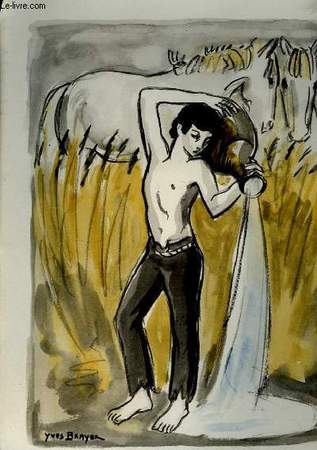
|
|
|
BRACQUEMOND, Félix / RABELAIS Bracquemond Félix
LES EAUX-FORTES DE RABELAIS dessinées par BRACQUEMOND
Paris Alphonse Lemerre, Editeur 1872 in 8 (21x13) 1 volume broché, couverture rempliée. Suite complète des 16 eaux-fortes originales hors texte, dont un portrait de Rabelais, et 15 eaux-fortes de Félix Bracquemond, chacune précédée d'un feuillet d'extrait du texte de Rabelais correspondant, et inspirées par le " Gargantua ". Exemplaire à toutes marges, imprimé sur papier vergé. Bel exemplaire ( Photographies sur demande / We can send pictures of this book on simple request )
Referentie van de boekhandelaar : 48001
|
|
|
Bracquemond (Félix)
Margot la Critique (ou la Pie) - Eau-forte originale de Félix Bracquemond (1833-1914)
l’Artiste 1858 - Béraldi 113 – 3e état sur 4 :Très belle épreuve sur chine collée- Feuille : 320 x 245- Coup de planche : 240 x 210 mm- Chine : 235 x 205 mm“Raucaque garrulitas studiumque immane loquendi. – C’est une Pie tenant une plume sous la patte, et qui jacasse à tort et à travers, la tête haute, les ailes étendues, posée sur un globe où se lisent les mots Paris, Opéra, Français, Musée, Palais, Académie, Ecole.”
Referentie van de boekhandelaar : 25984
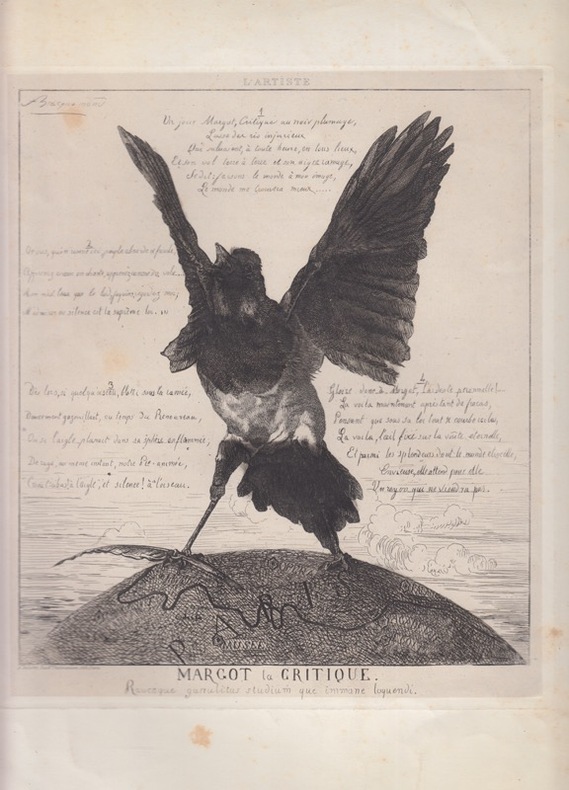
|
|
|
BRACQUEMOND Félix
Portrait de femme.
Tirage de la Gazette des Beaux-Arts de mai 1876. Elle a été imprimée par Salmon. D’après Ingres. Belle épreuve sur vergé. IFF nc. Béraldi nc. Rousseurs dans les marges. en feuille Bon 1876 24,8 x 16 cm, feuille 27,8 x 20 cm.
Referentie van de boekhandelaar : 7286
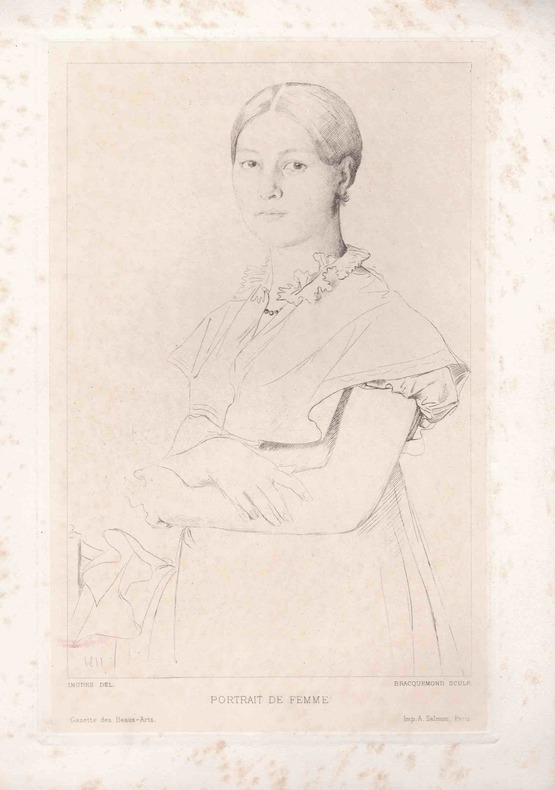
|
|
|
BRACQUEMOND Félix
Portrait de femme.
Tirage sur vergé. Elle a été imprimée par Salmon. D’après Frans Hals. Belle épreuve, réalisée pour illustrer le catalogue de la vente de la Galerie Péreire en 1872. Béraldi 332. IFF 328. 1872 17 x 13,5 cm.
Referentie van de boekhandelaar : 7290
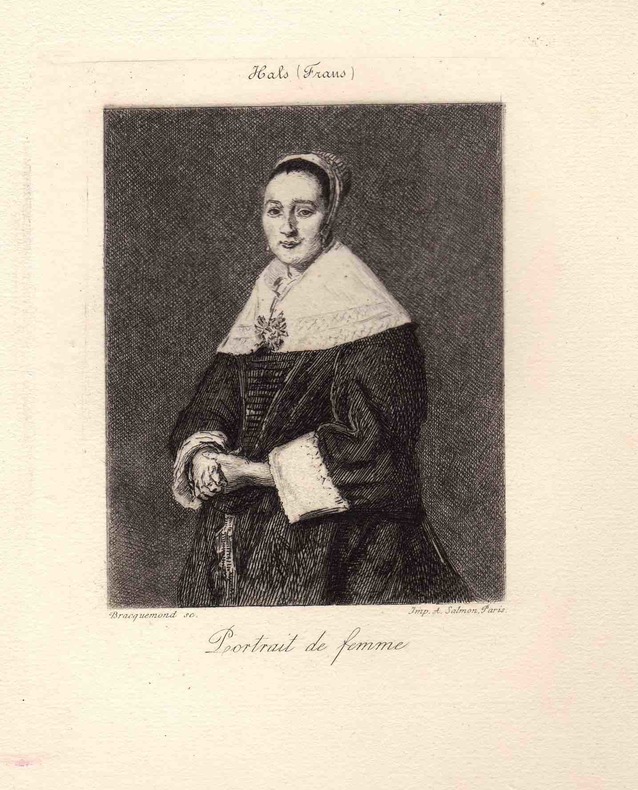
|
|
|
BRADLEY Will H. Bradley Will H.
WHEN HEARTS ARE TRUPS BY TOM HALL (Quand les coeur sont l'atout). Les Maitres de l'Affiche Pl. 52
0 Planche N°52, format 29 x 40 cm (toutes marges). Chromolithographie d'époque avec le timbre à sec de l'Imprimerie Chaix (Lugt 1777c). Notre exemplaire est une des très rares épreuves imprimées sur papier Japon, 2 toutes petites traces de punaisage sur l'extrémité de la marge supérieure (Our plate is one of the few copies printed on Japanese paper. Original plate in good condition). LES MAITRES DE L'AFFICHE, prestigieuse publication d'art, éditée par l'atelier de lithographie Chaix, dont la parution s'étala de décembre 1895 à novembre 1900. Chaque livraison comportait 4 planches de reproduction en chromolithographie d'une remarquable qualité d'impression des plus belles affiches illustrées des grands artistes français et étrangers (auxquelles il faut ajouter 16 planches de lithographies originales offertes en prime aux abonnés). Lors de l'Exposition universelle de 1889, fut organisée la première exposition rétrospective dévolue à l'affiche, celle-ci devait valider la reconnaissance officielle d'appartenance de l'affiche au monde de l'art. Jules Chéret (1836-1932) y sera sacré '' Maître de l'affiche '', c'est aussi à cette date que Seurat commencera à collectionner les affiches de Chéret. Bel exemplaire ( Photographies sur demande / We can send pictures of this book on simple request )
Referentie van de boekhandelaar : 24181
|
|
|
Bracker, Jörgen / Frisch, Dieter (Hrsg.)
Rolf Zander. Winterlager. Verzeichnis seiner Radierungen von 1955 bis 1990 aus.
Hamburg, Sautter & Lackmann, 1994. 112 nn. S. Mit zahlr., tls. farb. Abb. 33 cm. OKart.
Referentie van de boekhandelaar : 97008
|
|
|
Bracker, Jörgen / Frisch, Dieter (Hrsg.)
Rolf Zander. Winterlager. Verzeichnis seiner Radierungen von 1955 bis 1990 aus.
Hamburg, Sautter & Lackmann, 1994. 112 nn. S. Mit zahlr., tls. farb. Abb. 33 cm. OKart.
Referentie van de boekhandelaar : 92376
|
|
|
Braham Jeanne with engravings by Barry Moser
The Light Within The Light : Portraits of Donald Hall Richard Wilbur Maxine Kumin and Stanley Kunitz
Godine 2007. First edition. Fine and bright in like dustjacket with crisp bright text throughout. Godine, 2007 unknown
Referentie van de boekhandelaar : 55904
|
|
|
Bramanti Bruno wood engravings
The Life of Christ as told in selections from the New Testament with wood engravings cut especially for this edition
New York: Pellegrini & Cudahy 1951. Hardcover. Very Good/Very Good. Black cloth ornately stamped in silver on spine; dust jacket; 8vo; pp. 131 with beautiful b/w wood engravings. Some light scuffing at spine tips and along edges of boards; silver spine somewhat darkened. Dust jacket tanned moreso along spine; some light chipping and small closed tears along joints and edges; VG in mylar not price-clipped. <br/><br/> Pellegrini & Cudahy hardcover
Referentie van de boekhandelaar : JC9113
|
|
|
Bramanti Bruno wood engravings
The Life of Christ as told in selections from the New Testament with wood engravings cut especially for this edition
New York: Pellegrini & Cudahy 1951. Hardcover. Very Good/Very Good. Black cloth ornately stamped in silver on spine; dust jacket; 8vo; pp. 131 with beautiful b/w wood engravings. Some light scuffing at spine tips and along edges of boards; silver spine somewhat darkened. Dust jacket tanned moreso along spine; some light chipping and small closed tears along joints and edges; VG in mylar not price-clipped. <br/><br/> Pellegrini & Cudahy hardcover books
Referentie van de boekhandelaar : JC9113
|
|
|
BRANDOLINI D'ADDA, Yasmin (Cape Town 1929 - Cison di Valmarino 2012)
Moon sequence
Cartelle di 6 incisioni a puntasecca originali, numerate, firmate e datate a matita dall'Artista (cm 22x16,5, foglio 50x35) Incisioni stampate su carta delle Cartiere Sant'Ilario di Pescia sui torchi di Giorgio Upiglio a Milano. Es. H.C. riservato allo stampatore. Cartella cm 50x35. . . Ottimo (Fine). . Edizione originale di 25 esemplari numerati. . Yasmin Brandolini D'Adda, di famiglia sudafricana di lingua inglese, ha vissuto a Londra e Firenze, dove ha studiato all'Accademi di Belle Arti.. Nel 1951 sposò il poeta e scrittore veneziano Brandolino Brandolini D'Adda. Ha esposto regolarmente sia in Italia che all'estero sin dal 1971.

|
|
|
BRANDOLINI D'ADDA, Yasmin (Cape Town 1929 - Cison di Valmarino 2012)
Moon sequence
Opera appartente alla serie di 6 incisione a puntasecca originale, numerata, firmata e datata a matita dall'Artista (cm 22x16,5, foglio 50x35) Incisione stampata su carta delle Cartiere Sant'Ilario di Pescia sui torchi di Giorgio Upiglio a Milano. Esemplare 8/25. . . . Ottimo (Fine). . Edizione originale di 25 esemplari numerati. . Yasmin Brandolini D'Adda, di famiglia sudafricana di lingua inglese, ha vissuto a Londra e Firenze, dove ha studiato all'Accademi di Belle Arti.. Nel 1951 sposò il poeta e scrittore veneziano Brandolino Brandolini D'Adda. Ha esposto regolarmente sia in Italia che all'estero sin dal 1971.

|
|
|
BRANDOLINI D'ADDA, Yasmin (Cape Town 1929 - Cison di Valmarino 2012)
Moon sequence
Opera appartente alla serie di 6 incisione a puntasecca originale, numerata, firmata e datata a matita dall'Artista (cm 22x16,5, foglio 50x35) Incisione stampata su carta delle Cartiere Sant'Ilario di Pescia sui torchi di Giorgio Upiglio a Milano. Esemplare 8/25. . . . Ottimo (Fine). . Edizione originale di 25 esemplari numerati. . Yasmin Brandolini D'Adda, di famiglia sudafricana di lingua inglese, ha vissuto a Londra e Firenze, dove ha studiato all'Accademi di Belle Arti.. Nel 1951 sposò il poeta e scrittore veneziano Brandolino Brandolini D'Adda. Ha esposto regolarmente sia in Italia che all'estero sin dal 1971.

|
|
|
BRANDOLINI D'ADDA, Yasmin (Cape Town 1929 - Cison di Valmarino 2012)
Moon sequence
Opera appartente alla serie di 6 incisione a puntasecca originale, numerata, firmata e datata a matita dall'Artista (cm 22x16,5, foglio 50x35) Incisione stampata su carta delle Cartiere Sant'Ilario di Pescia sui torchi di Giorgio Upiglio a Milano. Esemplare 8/25. . . . Ottimo (Fine). . Edizione originale di 25 esemplari numerati. . Yasmin Brandolini D'Adda, di famiglia sudafricana di lingua inglese, ha vissuto a Londra e Firenze, dove ha studiato all'Accademi di Belle Arti.. Nel 1951 sposò il poeta e scrittore veneziano Brandolino Brandolini D'Adda. Ha esposto regolarmente sia in Italia che all'estero sin dal 1971.

|
|
|
BRANDOLINI D'ADDA, Yasmin (Cape Town 1929 - Cison di Valmarino 2012)
Moon sequence
Opera appartente alla serie di 6 incisione a puntasecca originale, numerata, firmata e datata a matita dall'Artista (cm 22x16,5, foglio 50x35) Incisione stampata su carta delle Cartiere Sant'Ilario di Pescia sui torchi di Giorgio Upiglio a Milano. Esemplare 8/25. . . . Ottimo (Fine). . Edizione originale di 25 esemplari numerati. . Yasmin Brandolini D'Adda, di famiglia sudafricana di lingua inglese, ha vissuto a Londra e Firenze, dove ha studiato all'Accademi di Belle Arti.. Nel 1951 sposò il poeta e scrittore veneziano Brandolino Brandolini D'Adda. Ha esposto regolarmente sia in Italia che all'estero sin dal 1971.

|
|
|
Braun John G
Currier & Ives 1971
Alhambra CA: C.F. Braun & Company 1971. 1st thus. Hardbound. NEAR FINE/ NoDJ as issued. As new except for faint sunning to top edge and tiny crease on bottom corner of first 2 free pages. "private edition for distribution to our friends." No text except for title and origin on each print. 28 full-page color prints with framing edge. 8.5x11" 21.6x27.9cm. C.F. Braun & Company hardcover
Referentie van de boekhandelaar : 02Y008
|
|
|
BREBIETTE Pierre
(La décapitation de Sainte Catherine ?)
IFF 27-45. Le Blond avec privilège du Roy XVIIè 11,5 x 16
Referentie van de boekhandelaar : 6623
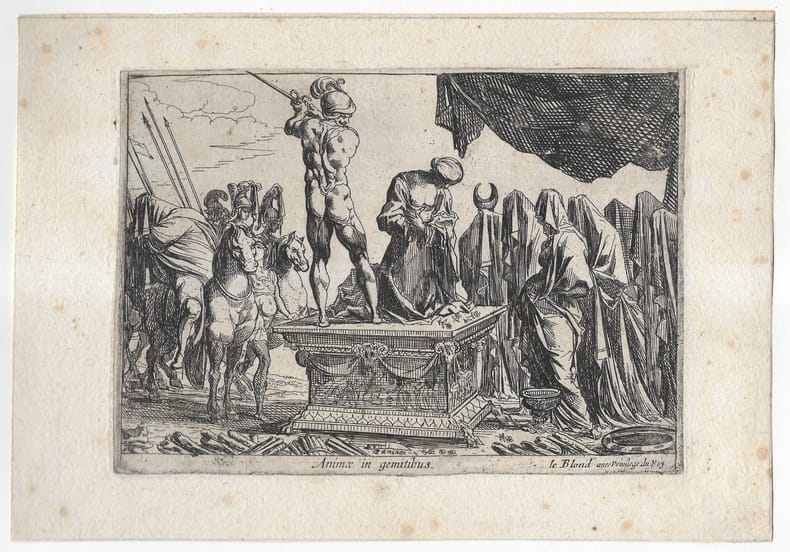
|
|
|
BRETON (André) - MAN RAY - COLLECTIF
André Breton. 42, rue Fontaine. Tome V : Tableaux modernes, sculptures, estampes, tableaux anciens.
Drouot Auction Paris 2003. Calmels, Cohen, Paris, vente aux enchères publiques des collections d'André Breton, du 7 au 17 avril 2003.- Le troisième des 8 volumes constitués. Tome V : Tableaux modernes, sculptures, estampes, tableaux anciens. in-4 broché au format (27 x 21 cm), couverture recouverte d'un plexiglass imprimé avec le portrait de André Breton, 160 pages et 200 illustrations. importante documentation et iconographie sur le SURREALISME.- 590g.- Edition originale en bel état.
Referentie van de boekhandelaar : 30766
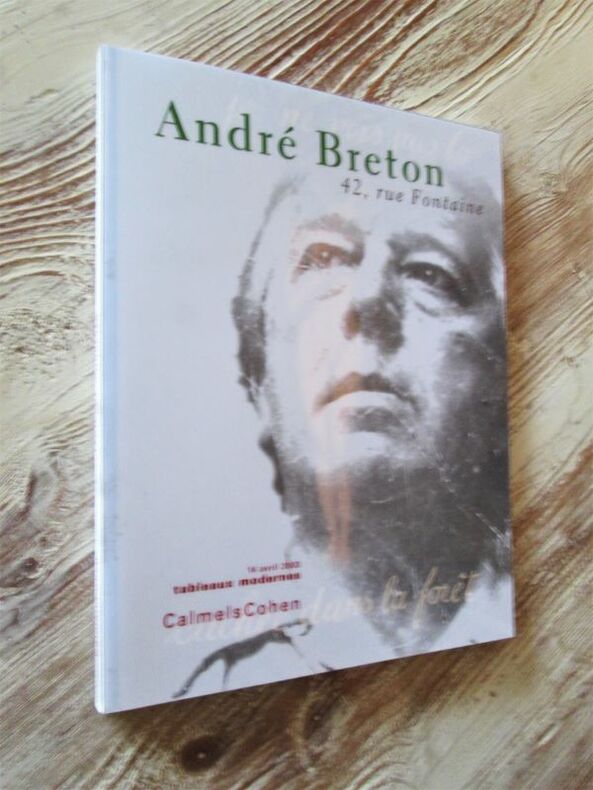
|
|
|
BRETON (André) - MAN RAY - COLLECTIF
André Breton. 42, rue Fontaine. Tome VII : Photographies.
Drouot Auction Paris 2003. Calmels, Cohen, Paris, vente aux enchères publiques des collections d'André Breton, du 7 au 17 avril 2003.- Le troisième des 8 volumes constitués. Tome VI I: Photographies. In-4 broché au format (27 x 21 cm), couverture recouverte d'un plexiglass imprimé avec le portrait de André Breton, 416 pages et 650 illustrations. importante documentation et iconographie sur le SURREALISME.- 1435g.- Edition originale en bel état.
Referentie van de boekhandelaar : 30767
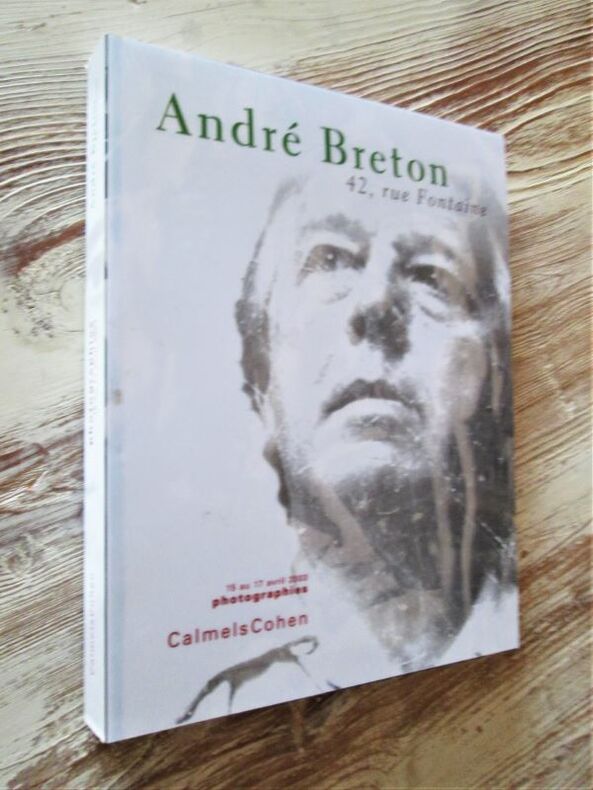
|
|
|
BRETON (André) - MAN RAY - COLLECTIF
André Breton. 42, rue Fontaine. Tableaux modernes (2 vol.)
Drouot Auction Paris 2003. Calmels, Cohen, Paris, vente aux enchères publiques des collections d'André Breton, du 7 au 17 avril 2003.- 2 volumes In-4 brochés au format (27 x 21 cm), couverture recouverte d'un plexiglass imprimé avec le portrait de André Breton, 153 et 328 pages, nombreuses illustrations. importante documentation et iconographie sur le SURREALISME.- 3kg.- Edition originale en bel état.
Referentie van de boekhandelaar : 31719
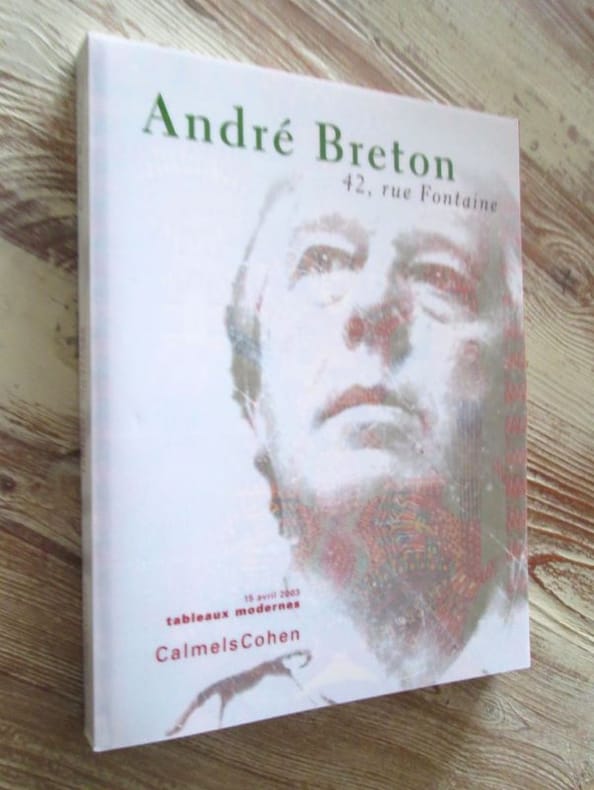
|
|
|
BRETON (André) - MAN RAY - COLLECTIF
André Breton. 42, rue Fontaine. Manuscrits.
Drouot Auction Paris 2003. Calmels, Cohen, Paris, vente aux enchères publiques des collections d'André Breton, du 7 au 17 avril 2003.- Le volume concernant les "Manuscrits". In-4 broché au format (27 x 21 cm), couverture recouverte d'un plexiglass imprimé avec le portrait de André Breton, 353 pages, nombreuses illustrations. importante documentation et iconographie sur le SURREALISME.- 1435g.- Edition originale en bel état.
Referentie van de boekhandelaar : 31720
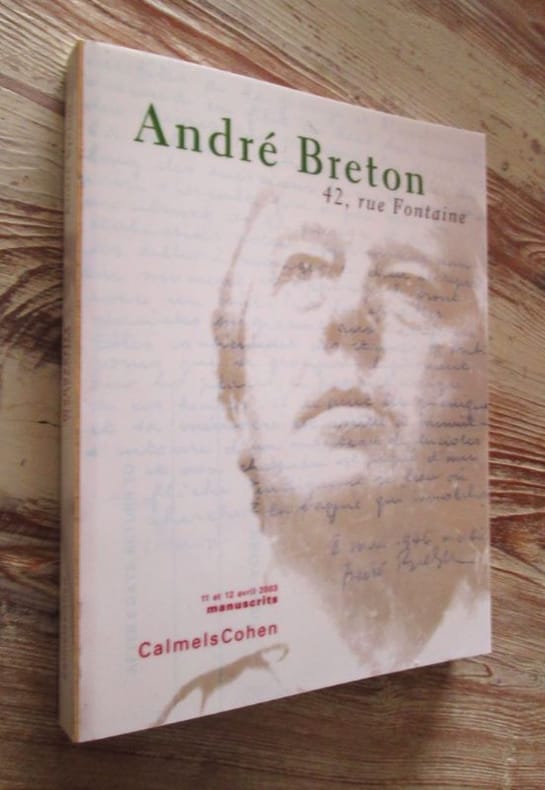
|
|
|
BRETTELL, Richard (contributions de). - GILLIS, Eric (contributions de).
Degas & Pissarro. Alchimie d’une rencontre.
Vevey, Cabinet Cantonal des Estampes - Musée Jenisch 1998, 315x230mm, 176pages, broché. Couverture à rabats. Cachet de possesseur sur le haut de la page de faux-titre, autrement bel exemplaire.
Referentie van de boekhandelaar : 106691
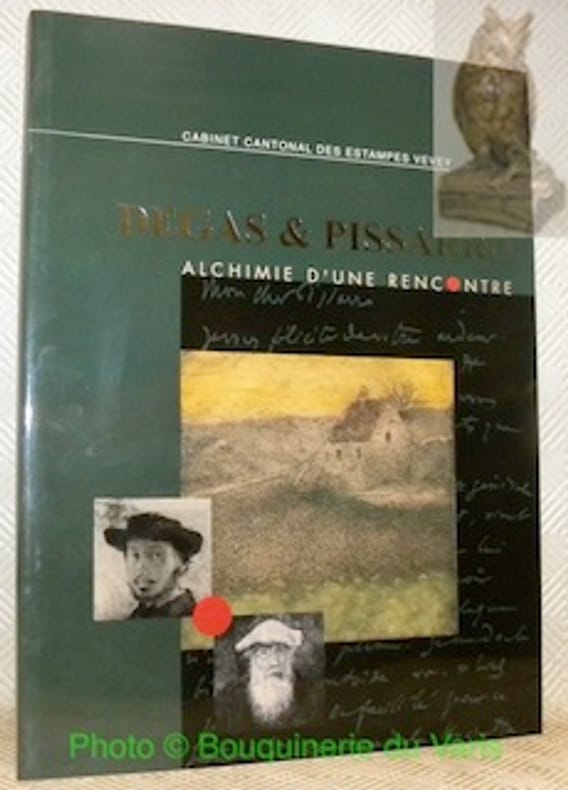
|
|
|
BREBIETTE Pierre
Sainte Famille
IFF 11, Le Blond excudit avec privilège du Roy. Habituellement on trouve le privilège d’Auguste Quesnel. (état postérieur) À gauche Saint Joseph et la Vierge tenant l’Enfant, dont Saint Jean Baptiste baise le pied. À droite Sainte Anne, une femme et S. Joachim. XVIIè 11,5 x 16
Referentie van de boekhandelaar : 6625
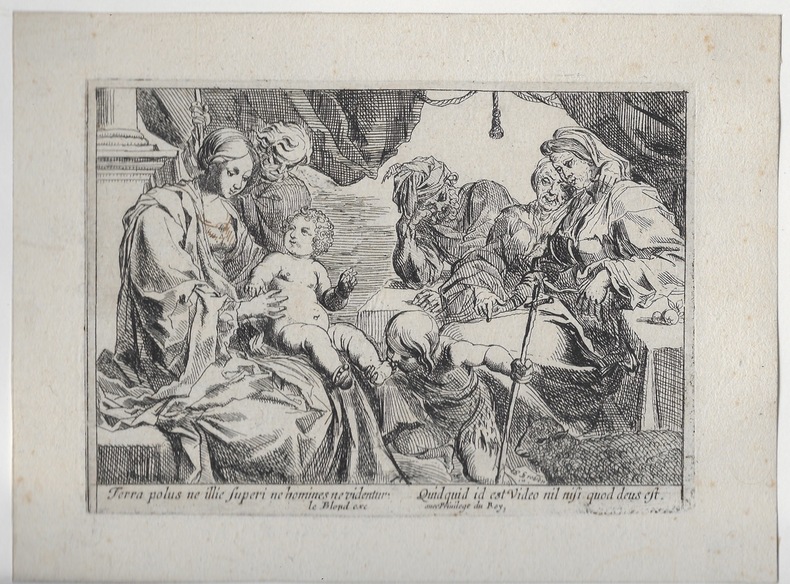
|
|
|
BREWSTER Jerry
ZUNIGA. The complete Graphics 1972-1984. Interview and essay by Burt Chernow
New York - London Alpine Fine Arts Collection 1984 in 4 (29,5x26,5) 1 volume reliure toilée beige de l'éditeur sous jaquette rempliée illustrée en couleurs, 245 pages, avec de nombreuses reproductions en couleurs. Catalogue of prints. 101 oeuvres reproduites et décrites en regard. Zuñiga. Texte en langue anglaise. First edition. Bel exemplaire ( Photographies sur demande / We can send pictures of this book on simple request )
Referentie van de boekhandelaar : 36840 ISBN : 881680079
|
|
|
BREDDO, Gastone (Padova 1915 - Calenzano 1991),
Senza titolo
Acquaforte facente parte delle pubblicazioni edite in occasione del 50° anniversario della fondazione del PCI. Ha partecipato alla biennale di Venezia nel 1958 con una sala personale, ottenendo uno dei premi ufficiali nazionali. Ha esposto a tutte le precedenti edizioni della Biennale di Venezia dal 1940 al 1958. Ha esposto varie volte alla Quadriennale Romana, anche con una sala personale all'ottava edizione. Ha quindi esposto nelle gallerie e nei musei di Roma, Firenze, Venezia, Bologna, Trieste, Torino, Milano, Padova, Taranto, Bari, Cortina D'Ampezzo, La Spezia, ecc. Ha collaborato alle riviste Gioventù Italica, Il Bo, L'architrave, La strada, Michelangelo, Gazzetta Veneta, Lettere e Arti Firma a matita in basso a destra. Esemplare 2/100. Cm 32x25 (Foglio 70x50). . . Ottimo (Fine). Piccola macchia di inchiostro e fioriture nella parte bianca del foglio, non interessanti la parte incisa. Tiratura 100. .

|
|
|
Brenner, Adam.
"Te Deum Laudamus". Lithographiertes Huldigungsblatt auf die Vermählung von Kaiser Franz Joseph I. und Kaiserin Elisabeth. Wien, B. Greiffenstein für J. Sedlaczek, 1854.
Kolorierte Lithographie auf Papier. 605 x 800 mm. Sehr seltene Monumentallithographie von Joseph Lanzedelli dem Jüngeren nach einem Entwurf von Adam Brenner, gedruckt bei B. Greiffenstein für J. Sedlaczek in Wien. Das Plakat zeigt eine Anbetung Jesu Christi als Himmelskönig auf textlicher Basis des "Te Deum Laudamus". Die irdische Sphäre ist zentral durch den schreibenden Heiligen Ambrosius von Mailand repräsentiert, dem der berühmte Hymnus zugeschrieben wird. Mehrere Textzitate mit Strophenangabe der deutschen Nachdichtung des Te Deums von Ignaz Franz sind illustriert, darunter die Anbetung der Cherubim. Erst durch die Bildunterschrift wird der Zusammenhang mit der Hochzeit des Kaiserpaares hergestellt: "Zur Erinnerung an die Oesterreichs Völker beglückende Vermählung und glorreiche Regierung Sr. kais. königl. Apostolischen Majestät unsers allgeliebten und allergnädigsten Kaisers Franz Joseph I., mit Ihrer königl. Hoheit der durchlauchtigsten Prinzessin Elisabeth Amalie Eugenie, Herzogin in Bayern". Die Betonung des Heiligen Ambrosius von Mailand als Schutzpatron des österreichischen Kaisertums hatte in der angespannten Lage vor dem zweiten italienischen Unabhängigkeitskrieg (1859) auch eine politische Dimension. - Der Wiener Kaufmannssohn Adam Brenner (1800-91) studierte unter Leopold Kupelwieser und Ferdinand Georg Waldmüller an der Akademie der bildenden Künste. Er trat sowohl in der Historienmalerei als auch in den niedrigeren Gattungen als begabter akademischer Maler hervor. - Mehrere geklebte Einrisse sowie fachgerechte Ergänzungen im Randbereich. Leicht fleckig und gebräunt.
|
|
|
Brett Simon introduction. Lawrence Stanley. Simon Brett Joan Hassell Edwina Ellis et al wood engravings of
A CROSS SECTION - THE SOCIETY OF WOOD ENGRAVERS IN 1988
Wakefield: Fleece Press 1988. 1st Edition Limited. Hardcover. Fine. 225 copies with 160 for sale quarter cloth. Fine apparently unused copy in light blue cloth slipcase that has a modestly faded edge. Dedicated to wood engraver Stanley Lawrence 1900-1987. Fleece Press hardcover books
Referentie van de boekhandelaar : 012539

|
|
|
BREWINGTON (M. V. & Dorothy)
Kendall Whaling Museum Prints.
First edition, 4to, 209pp., coloured frontis., numerous illustrs., throughout, orig. cloth.
|
|
|
Brillat-Savarin (Anthelme) :
Aphorismes. Menus et Variétés. Gravures originales à la manière noire de Mario Avati.
Paris, Les Francs Bibliophiles, 1961 ; in-8 en feuilles ; couverture crème imprimée en bleu marine rempliée, étui de suédine noire (emboitage de l'éditeur) ; (3) ff. blancs, 108, (8) pp., (3) ff. blancs, 25 gravures dont 1 en frontispice, protégées par des serpentes de papier de soie.
Referentie van de boekhandelaar : 6087
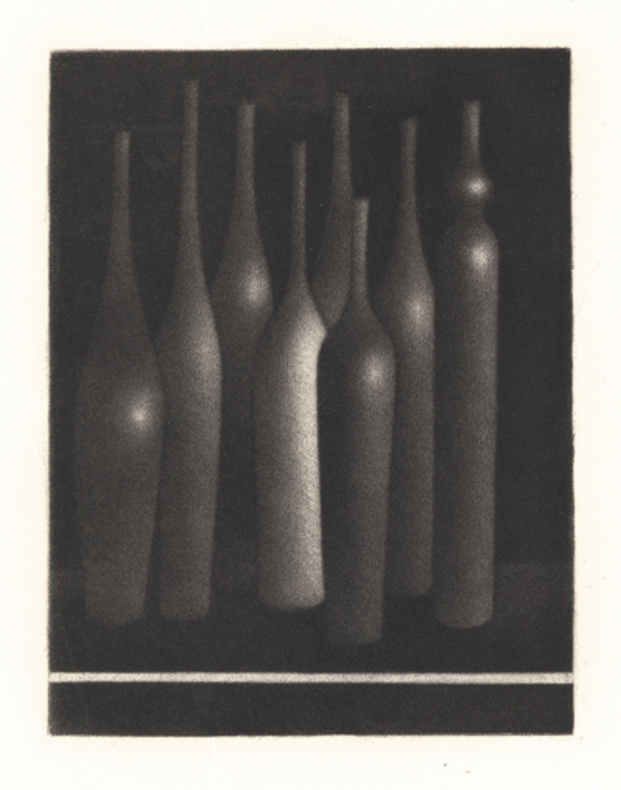
|
|
|
BRIDGE Joé & WILLETTE Adolphe POULBOT Francisque
République de Montmartre - souscription pour l'arbre de Noël des petits poulbots au cirque Médrano
- L'Emancipatrice, 5, rue de Pondichéry, Paris 1929, 10,5x13,7cm, une feuille. - Rarissime bulletin dépliant de souscription pour l'arbre de Noël des enfants de la République de Montmartre, surnommés les "petits poulbots", datant de l'année 1929. Sur le premier plat, figure une belle estampe originale signée Francisque Poulbot représentant deux petits enfants devant la cheminée, et légendée "-Pleure pas, y a notre arbre de Noël au mois de Janvier". Sur le second plat, une seconde estampe donne le lieu du rendez-vous : un enfant chuchote à un autre "ça sera à Médrano". Dans l'esprit de la Commune de Paris, la République de Montmartre fut créée en 1921 par les artistes parisiens Joé Bridge, Adolphe Willette, Jean-Louis Forain, Francisque Poulbot, Maurice Neumont, Louis Morin, Maurice Millière, Raoul Guérin et Jules Depaquit. Ses fêtes et banquets, souvent organisés dans les lieux mythiques de Montmartre (Moulin de la Galette, cirque Médrano, Moulin Rouge) eurent pour but de souder la communauté montmartroise par l'entraide et la sociabilité. Rare et esthétique témoignage du traditionnel "Arbre de Noël" des enfants défavorisés de la République de Montmartre, qui se déroulait non pas en décembre mais en janvier. [ENGLISH DESCRIPTION ON DEMAND]

|
|
|
BRIEGER, L
Das goldene Zeitalter der französischen Illustration.
Berlin, Harz, (1924). 4to. 47, (3) S. m. 34 Textabb., 64 Taf. OLwd (kl. Sammlerstempel auf Titel).
Referentie van de boekhandelaar : 1228382
|
|
|
Brighton Prints
BYGONE BRIGHTON A PORTFOLIO OF PRINTS
Brighton: Brighton Library. Very Good. 4to 12 Prints of Brighton in a folder. 1. MARINE PARADE BRIGHTON Published by C & R Sickelmore Printers Kings Road Brighton This view of Marine Parade was made in the mid-1820s. On the right is Tuppen's Royal Marine Library and in the middle is the entrance and approach to the Chain Pier roughly on the site of the present Aquarium. The round building just left of centre is Lamprell's later Brill's Baths. 2. THE BATTERY BRIGHTON Drawn by Edward Fox. Engraved by George Hunt. Published by C & R Sickelmore Stationers 26 King's Road Brighton. The West Battery stood near the site of the present Grand Hotel. It was erected in 1793 and removed in 1859. This view was made probably about 1824. 3. THE OLD STEINE BRIGHTON Entered at Stationer's Hall C. Graf Lithog. 1 Gt Castle St London. Pubd. by Taylor & Taberer Late Leppard 16 & 17 East Street. The Fountain was erected in 1846 and this print was published between 1853 and 1855. 4. POOL VALLEY - BRIGHTON Published by J. Smith Pool Valley 1843. The site of the present Southdown Motor Services bus station. 5. STEINE VIEW OF BRIGHTON ROYAL CHAIN PIER Drans Engraved Printed and Published by J. Bruce Brighton The Chain Pier was designed and executed by Capt. S. Brown and opened to the public in 1823. It was destroyed during a storm in 1896. This picture shows it just a year or two after it was built. 6. INTERIOR VIEW OF BRIGHTON ROYAL CHAIN PIER. Bruce Brighton. Another early view this time from the seaward end. 7. THE GERMAN SPA QUEENS PARK BRIGHTON Eng. by J. Newman. Drawn by F. W. Woledge. The German Spa was opened by Dr. F.A. Struve in June 1825. It sold chemical imitations of the waters of well-known Continental spas. These could be consumed on the premises or bottled waters could be bought in the town in London and from agents in several provincial towns. This engraving shows the spa in 1841. 8. THE BRIGHTON TERMINUS OF THE LONDON & BRIGHTON RAILWAY. Drawn byF. W. Woledge. Eng. by J. Newman. This building was designed by David Mocatta in the Italian style. The railway was opened in 1841 and this engraving shows the building in its original form and before the building of the bridge over Trafalgar Street in 1845. 9. THE BRIGHTON VIADUCT ACROSS THE PRESTON-ROAD Illustrated London News June 13 1846. The viaduct was built between May 1845 and March 1846 and was opened for general traffic in June 1846. 10. THE NATIONAL SCHOOL Day & Haghe Lithrs. to the King 17 Gate St London. Drawn and Pubd. by H. Mew Builder & Surveyor Mighell St Brighton; Nov. 1831. The Central National School was built in 1829 by Stroud and Mew and later enlarged by Cheesman. It was a fine example of Regency Gothic architecture and was demolished in 1971 despite much public outcry. 11. A SCENE AT THE DEVIL'S DYKE near BRIGHTON in the County of Sussex Taken on the spot & engraved by I. Burce. Published August 3 as the Act directs at No. 84 St. James Street Brighton 1826 12. CRICKET MATCH PLAYED BETWEEN SUSSEX & KENT 1849 painted by W.H. Mason. This picture was not intended as a record of a specific match but rather as a pciture "worthy of the noble and scientific game it is intended to illustrate". As well as cricketers from the two counties it shows supporters and others interested in the game. . Brighton Library unknown
Referentie van de boekhandelaar : 143895

|
|
|
BRINDISI, Remo (Roma, 1918 - Lido di Spina, 1996)
Sei incisioni a colori per la Storia della colonna infame di Alessandro Manzoni
Sei acqueforti acquetinte a colori originali, numerate e firmate a matita, di Remo Brindisi per la Storia della colonna infame. Introduzione critica di Roberto Sanesi Tiratura delle incisioni realizzata con torchi a mano su cartoncino Magnani per incisioni. Testo composto e impresso dalla Tipografia Annesio Nobili di Pesaro. Opera ideata e curata da Piergiorgio Spallacci. Es. VII/XXV. Cm 55x37,5. pp. 32. . Ottimo (Fine). . Edizione originale di 125 + XXV es. numerati. .

|
|
|
BRINDISI, Remo (Roma, 1918 - Lido di Spina, 1996),
Senza titolo
Litografia a colori Firma a matita. Esemplare 76/99. cm 65x45 (Foglio 71x50). . . . . Tiratura 99. .

|
|
|
BRINDISI, Remo (Roma, 1918 - Lido di Spina, 1996),
Senza titolo
Acquaforte Firma a matita. Il foglio reca il timbro a secco del Museo di Castelvecchio di Verona e quello della Stamperia del Cappello. Esemplare 96/100. Cm 24,5X30 (Foglio 50x70). pp.. Dedica e firma autografa dell'Artista ad un noto scrittore italiano (Inscribed and signed by the Author to an important Italian literary man). Ottimo (Fine). . Tiratura 100 + XI f.c.. .

|
|
|
Brion de La Tour Louis
Les Isles Britanniques map
Paris: Desnos 1766. Map. Fine. Matted hand-colored copper engraving. Image size: 12 x 11 inches. Mat size: 17.5 x 18.5 inches. From de La Tour's Atlas G�neral Civil et Eccl�siastique. This map can be found in several formats: with or without the separately printed decorative border and with or without the text. This copy has the border; it does not include the text sometimes found adjacent to the map. In Fine Condition: clean and bright. <br/><br/> Desnos unknown
Referentie van de boekhandelaar : 004430

|
|
|